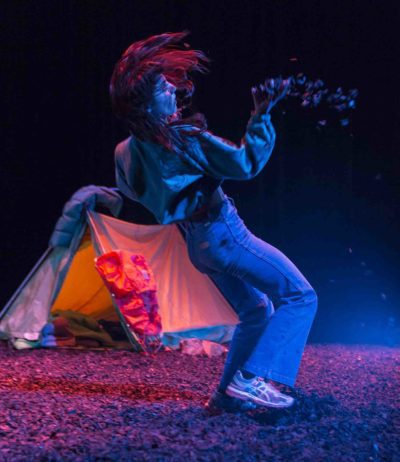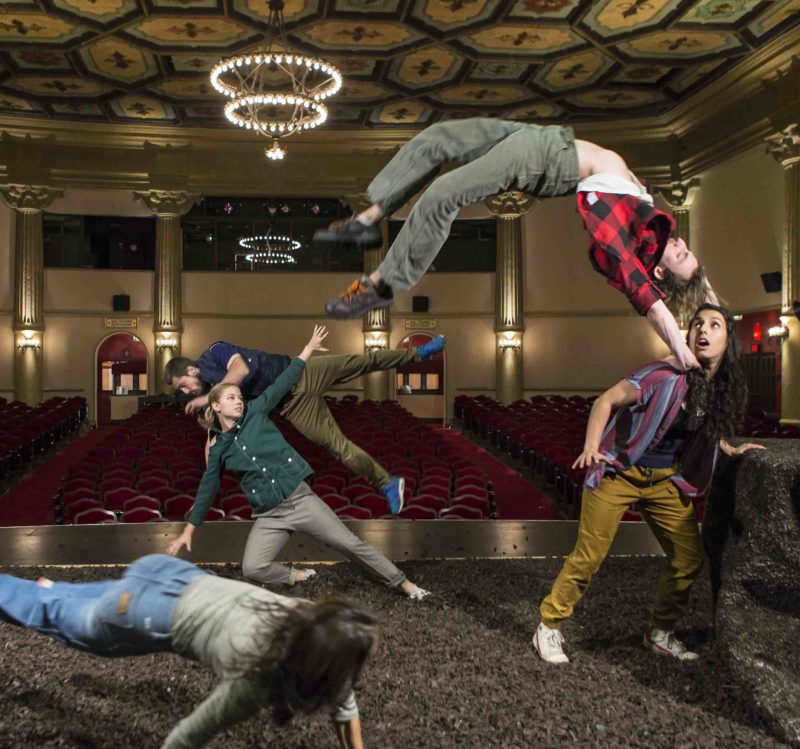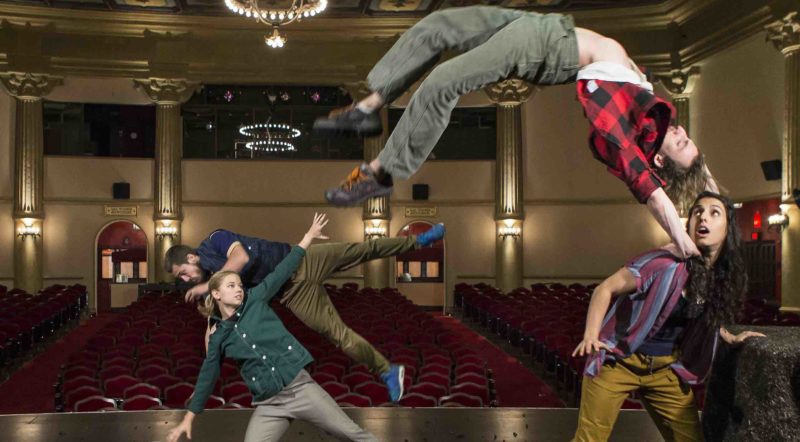INTERVIEW: Vim Vigor Dance Company goes camping in new show

The opening video on Vim Vigor Dance Company’s website offers a promise of things to come. Set to a haunting, owl-hooting soundtrack, the visuals of the company’s new dance splash across the screen. Men and women move, both gracefully and frenetically, around a stage made to look like a camping site. Flashlights and a blue aura highlight their swooping motions, and the ground kicks up a pile of dirt each time a step is taken.
This is physical dance theater.
Shannon Gillen founded Vim Vigor a few years ago and has built an impressive repertory with her first choreographic ventures for the company. The troupe of performers will present their latest work, Future Perfect, at Baruch Performing Arts Center in New York City, Feb. 2-11. Audiences can expect a movement-based journey into the land of memories and nature, where a camping site becomes the stage for human exploration.
Future Perfect follows the company’s debut piece, Separati, which played New York and Santa Barbara, California.
“I think with Separati, the first piece that Vim Vigor debuted in New York, it was really about introducing a different kind of … aesthetic,” Gillen said recently in a phone interview. “It doesn’t really exist here as much. I think my biggest inspirations in New York are going to be like Martha Clarke or big dance theater, but combining this pretty bombastic floor work, aesthetics, the style of dancing in combination with people that are, in my eyes, the actors, I felt was new for the New York scene. So Separati, I think, kind of launched that into space, and we had such a strong reaction, which was wonderful.”
Future Perfect began with a DANCEworks residency at the Lobero Theatre in Santa Barbara. Gillen had the chance to create a new work that built off the success of Separati and pushed the aesthetic even further.
“The set is way more extreme for Future Perfect,” she said. “The piece’s characters were more developed. We spent more time with them. On a brass tax level, there’s more language that’s in Future Perfect, and there’s more risk with humor. As dark as the work can be, this particular production, I think, has a lot more hope than Separati had, which always feels risky, maybe not with a California audience, where we were received very, very well. But I always get nervous to show something that has hope in it to a New York audience. I just hope at this time that people are available to it, so, yeah, I feel like Future Perfect takes the things that we had brought forth in Separati — sort of wild, bombastic, ecstatic dancing. … It’s virtuosic dancing that brings storytelling to the forefront in what feels to be a dance theater immersive environment, so an audience really feels like they’re almost at a film. They’re experiencing sort of like live-action film is the hope for our aesthetic.”
The piece stars Jason Cianciulli, Rebecca Diab, Martin Durov, Laja Field and Emma Whiteley. Gillen, very much a Renaissance artist, directed, choreographed, wrote and designed the set for Future Perfect. The sound was designed by Durov, while Barbara Samuels took care of the lighting and Joseph Blaha the costumes. “We make everything in house,” Gillen said. “It’s all original music. It’s all original.”
The concept of the show deals with camping and Gillen’s memories of being outdoors in the early 1980s. She added in stories and memories from the company members and even people they talked to while performing in California. Future Perfect is truly a collaborative work.
“When we went back to reframe the show here in New York, it just felt like an opportunity to make our story even better,” Gillen said. “For us, it was great success, but I felt like it needed to be anchored better. There were great ideas with the characters, but I wanted to give them a fuller through line and clearer transformation. I think a lot of our work is about what are the things that we come into contact with that transform us, and if we’re going to show that, we got to make sure it’s going to be clear to our audience. And I felt like we could work on that when we got to New York. That’s what we’ve been up to.”

When Gillen and Vim Vigor create dance pieces, they are conscious of the individual performers who are assembled in the rehearsal space. In fact, this concept of building movements based on the uniqueness of these dancers is important to the choreographer.
“I personally feel like all work is wholly dependent upon the people that are doing it, and even if you ask me about work that people have handed down generation to generation, I think that work has changed,” she said. “Other people don’t see it this way, and I think it’s maybe more true with the work that I make for sure. But, yeah, I think it’s specific to the people involved. … For instance, we created Separati and Rebecca who is our new apprentice will take that piece on because we have shows in New York at the end of May. … That means literally we have to go back in and totally rebalance the show. How drastically that changes the show has yet to be seen, but the feeling is you have to come in and take the ideas and make them their own and not in a subtle way. I think in a really profound way, that the chemistry changes on the stage.”
In many ways, Gillen comes back to the interesting and sometimes contentious divide between what makes a dancer a dancer and what makes an actor an actor.
“I think actors are given a lot of leeway to come into a production, even if they’re doing like a [William] Shakespeare production or like an Arthur Miller play,” she said. “I feel like they’re given space to really take it and make it truthful for themselves. I feel like a lot of dancers don’t really see it as authentically that way, as truthfully that way, and I really encourage performers to do that, to own material for themselves, to make sense of their context, to make sense of the constellation of what’s happening on stage versus just sort of like sitting in to what had been done before. And maybe that also takes an audience to acclimate to the individuality of dancers, which I think is also a new concept. I think dance audiences have gotten used to people being replaceable, which I find insane.”
Bringing the dreams of Vim Vigor Dance Company to life is challenging in a landscape where funding is tight, rehearsal time can be costly and the arts seem to be wedded to money. Gillen called their work “real” and “very challenging,” and she refuses to shortchange the process. When creating a new work, she wants the dancers to work full time on the piece, and she values the developmental, experimental stage.
“I really fundamentally believe in bringing world-class dancers into a setting that means we’re working full-time works, and we’re developing pieces not in a short span of time,” she said. “We’re developing them over months, and all of that is a huge investment. And I think the only solution to find success in that is to be able to reach populations that maybe didn’t care about the dance as much, or maybe only go to theater, or don’t go either but like music, really try to, without losing the art in what we’re doing, make the artwork accessible. I really believe that accessibility is a dirty word in the arts, and it’s not to me at all. It means that you can reach people, and I’m interested in doing that.”
Vim Vigor has met many of its original goals. After Separati went so well, they are back with Future Perfect and presenting in a respected venue over the course of two weeks. Not every company can say the same.
But this success didn’t come overnight. Gillen has been working in New York City for more than a decade and in Europe for a number of years as well. Over the years, she has developed a unique style of physical dancing that stresses emotion, narrative and cinematic imagination. Her many credits include being a company member at Johannes Wieland Company at the Staatstheater Kassel in Germany, receiving commissions from a host of international companies and graduating from The Juilliard School.
Today, she’s focused on making Vim Vigor sustainable for the long run.
“I feel that there’s a long way to go in creating the infrastructure to keep the company going and solid and able to create fresh work,” she said. “I feel that we could reach even more people. I think we would love to tour more than we are right now. One of the reasons why I think touring is interesting is because not just to go there and get a quick show out, but to actually spend time in certain places and develop relationships with those institutions and affiliate with other organizations, so that when we come back, we can also offer education, which I think is an underrated part of what dance companies do. In that I feel like people discount master classes, but I feel like master classes and community sessions and new ways of engaging our audiences, that’s the fertile ground with which the arts can survive in the economy of the U.S. So when I say touring, I really mean also making an investment in those communities.”
By John Soltes / Publisher / John@HollywoodSoapbox.com
Vim Vigor Dance Company will present Future Perfect at the Baruch Performing Arts Center in New York City, Feb. 2-11. Click here for more information and tickets.

